
To learn more about the guidelines about travel to Israel - click here


City of David/Hezekiah’s Tunnel & Pool of Siloam
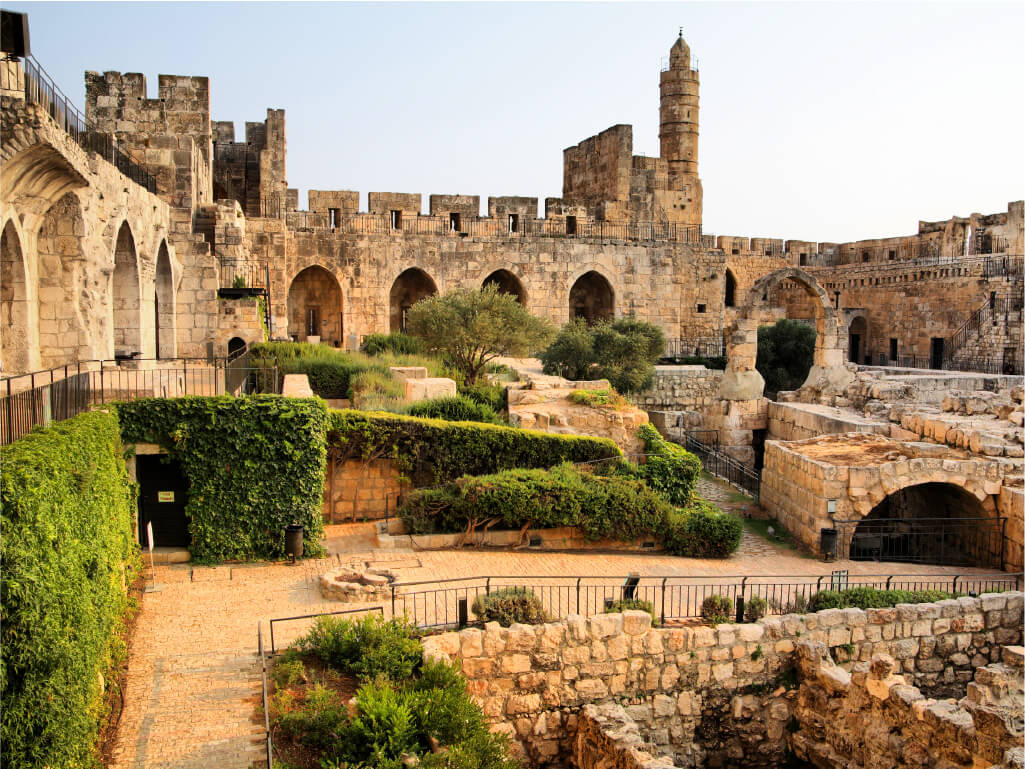
Jerusalem (Yeru-shalayim), usually translated from Hebrew as “the City of Peace,” is the crown jewel of Israel that shines at 2,500 feet above sea level. Jerusalem is a large, modern city today, but the “proper” City of David was much smaller. The ancient City of David sat on the narrow ridge of a hilltop, slightly south of what is today called the “Old City.” For over 150 years The City of David has been revealing some of the most important archeological discoveries of the ancient world. During the days of Abraham, some 4,000 years ago, the first foundations of the city were laid by the Jebusites
One thousand years later, King David left the city of Hebron, conquered the Jebusite city, and establish a unified capital of the tribes of Israel in Jerusalem. Years later, King Solomon, David’s son, built the First Temple north of the city on Mount Moriah, the very site where Abraham offered Isaac to the Lord.
The location for the city that David claimed had two important attributes: fresh water from the Gihon Spring, and the defensive security of being on this steep hillside. The Kidron Valley protected the extremely narrow city on the east, with the west guarded by the Central Valley, and the south by the Hinnom Valley’s merger with the other two.
There are so many sites to see here. A tour of the City of David begins with an observation point of biblical Jerusalem overlooking the Kidron, Central and Hinnom Valleys As you move through the city you will see archaeological excavations and thrilling biblical finds spanning thousands of years of history including both First and Second Temple Jerusalem. Continue underground to the Gihon Spring, the major water source of Jerusalem for over 1,000 years. From here you can choose to trek through knee deep water in King Hezekiah's 2,700-year-old water tunnel or walk through a dry tunnel immersing yourself in the wonders of early engineering. Then continue to the Shiloah Pool, the major water source in biblical times, and reach the Herodian Road, the ancient thoroughfare that led pilgrims north to the Temple.
Today’s visitor can see the ruins of David’s Palace, discovered in 2005. There are two parts: The Stepped Stone Structure (the Millo) and the Large Stone Structure (2 Samuel 5:7-9, 16:22).
A visit is your passport to the past and biblical Jerusalem.
Hezekiah’s Tunnel
To understand Hezekiah’s Tunnel and to truly appreciate this tremendous feat of engineering, some background is needed. Judah had been reduced by Assyria to a vassal state, as was most of the world, but when Sargon King of Assyria died these suppressed kingdoms rebelled…and were crushed by his son Sennacherib’s armies (Micah 1:8-12).
Hezekiah was the king of Judah at this time (726-697 B.C.), and he refused to pay tribute to Sennacherib (2 Kings 18:7), trusting in an alliance with Egypt instead (Isaiah 36:4-7). The natural response to this rebellion was to invade Judah, which prompted Hezekiah to agree to pay the tribute of 300 talents of silver and 30 talents of gold, but he did so by stripping down the Temple (2 Kings 18:14-16).
This concession was too little, too late, though, and Assyria marched on Jerusalem (Isaiah 36:1-2). Withstanding this siege would require ensuring there would be enough water for the city to survive, which meant a tunnel would need to be dug from the spring (2 Chronicles 32:1-4).
In 1880, a boy discovered an inscription on the tunnel wall while bathing. It has since been removed to the Istanbul Museum, but it explained the rare engineering feat of digging through solid bedrock with picks, axes, and a bucket brigade. It described two teams digging simultaneously from opposite directions:
“And when the tunnel was driven through...the hewers wielded the ax, each man toward his fellow...there was heard a man's voice calling to his fellow...the hewers hacked each toward the other, ax against ax, and the water flowed from the spring to the pool, a distance of 1,200 cubits....”
In 1867, Charles Warren conducted the first excavations of the Temple Mount. Warren is credited with the discovery of the water shaft that brought water from the Gihon Spring into Jerusalem in ancient times. In honor of his work, the shaft was named Warren’s Shaft, as he was the first one to actually walk it for centuries.
Hezekiah’s Tunnel is a remarkable experience, though not as difficult today as when Warren first discovered it. Still, at 2 feet wide and 5 feet high for much of the tunnel, it can be a bit of a challenge. On a summer day, the 63-degree, spring-fed water is very refreshing, but not advisable during the winter months without a change of clothes, because you will get wet (the water level rises from your ankles to your knees to your waist). Give yourself about 40-60 minutes to wade through the 1,740-foot tunnel and be sure to bring a flashlight or headlamp
If you don’t want to get wet, then you can take the dry Canaanite Tunnel (to the immediate left of the main tunnel), which was used for crop irrigation. It’s narrow, but completely passable. The source of the water’s flow, the Gihon Spring, is also famous as the spot where Solomon was crowned King of Israel (1 Kings 1:38-40). Standing on the very ground where Solomon was anointed king is something you can experience as part of the underground, dry tunnel walk.
You can also walk down the Herodian street (also underground) that myriads of Jews walked up to the Temple from the Pool of Siloam. This is the same path Jesus would have used 2,000 years ago. These tunnels were the last hiding places during the Roman destruction, and excavations in the tunnels revealed a Roman sword in its leather sheath.
The whole tunnel system exposes an aspect of Jerusalem that leaves you astounded at the engineering skill involved. When you consider what it took to complete the construction above ground, what Ilies beneath only adds to the marvel of the City of David.
Pool of Siloam
In 2004, an old Turkish sewage pipe exploded in Jerusalem and during the subsequent repair, two ancient stone steps were found by the construction crew. Normally this would not make much news in Israel, even though it was near Hezekiah’s Tunnel that carries fresh water from the Gihon Spring, but the coins and pottery found dated it from the Second Temple period. It proved to be vastly important as these steps led the excavators down to where John recorded Jesus had healed a blind man (John 9:1-12).
Located south of the City of David, on the west side of the eastern hill, the recently excavated reservoir is shaped like a trapezoid, with three sets of five steps that run for 225 feet alongside it. This massive pool dates to the siege of King Sennacherib of Assyria and King Hezekiah’s famous water tunnel in the 8th century (2 Chronicles 32).
There are two pools that were identified as the Pool of Siloam. The traditional and older Pool of Siloam, now called the Byzantine Pool, was discovered in the 5th century. It is a narrow rectangle that was fed by the waters from Hezekiah's Tunnel. Around 450 A.D., a church was built next to it by the Byzantine empress Eudocia, which the Persians destroyed in 614 AD. Early Christian pilgrims came here to celebrate Jesus' miracle, but it was the wrong pool.
The much larger 2004 Pool of Siloam is about 70 yards away from the older pool, and the actual one that John records in his Gospel. It had disappeared under centuries of winter rains that sent sediment and debris downhill, on top of the destruction from 70 A.D. Before this burial, the pool was an important part of the Feast of Tabernacles.
Jewish pilgrims brought their harvest crops here in a musical procession, waving a palm branch with myrtle tied to it by a golden thread (lulav) in one hand and a citrus fruit (etrog) in the other, to watch the priest draw water from the pool in a golden pitcher, which was then taken to the Temple with great fanfare and trumpets (Leviticus 23:40-40). The High priest would receive it from him and pour it into a basin, with a second pouring of wine into a separate basin while singing praises to God from Psalm 118 (Isaiah 12:3).
It was at this moment, when there was a silent pause in the ceremony, that Jesus revealed Himself as the Sent One, promising “living water” to “save now” those who had “gained their sight” by believing in Him (John 7:37-38). As they sang Psalm 118:22-27, they prophetically confirmed Him as their Messiah,
The Greek word Siloam is derived from the Hebrew word “shiloach,” which means, “sent” Our English equivalent is “apostle,” which means, “sent one.” Interestingly, the Sent One only does two miracles in Jerusalem. Jesus heals a lame man at the Bethesda Pool (John 5:2-9) and a blind man at the pool of Siloam, both of which have added significance to His Davidic identity from 2 Samuel 2:5-8,
The rest of the pool, extending an additional 120 feet, remains buried, The Greek Orthodox Church who owns the property has not allowed the excavation to continue.
FROM THE SCRIPTURES
And David lived in the stronghold and called it the city of David. And David built the city all around from the Millo inward. And David became greater and greater, for the LORD, the God of hosts, was with him (2 Samuel 5:9 ESV).
Awake, awake, put on your strength, O Zion; put on your beautiful garments, O Jerusalem, the holy city; for there shall no more come into you the uncircumcised and the unclean. Shake yourself from the dust and arise; be seated, O Jerusalem; loose the bonds from your neck, O captive daughter of Zion. (Isaiah 52:1-2 ESV).
This same Hezekiah closed the upper outlet of the waters of Gihon and directed them down to the west side of the city of David. And Hezekiah prospered in all his works (2 Chronicles 32:30 ESV).
SITES TO SIGNIFICANCE
Itineraries.
- LATEST INFORMATION AND UPDATES
- ISRAEL GOVERNMENT TOURISM OFFICES
- ISRAEL IN THE MEDIA
- STATISTICS AND RESEARCH

Photographers: Guy Yehieli, Adam Primer, Kfir Boltin, Linnea Andres, Kfir Sivan, Haim Yafim, Dana Fridlander, refael Ben Ari, Itamar Greenberg, Moshik Lindbaum, Ori Ackerman Video Credits: Israeli food channel, National Geographic
- OFFICIAL BROCHURE
- TERMS OF USE
- PRIVACY POLICY
FOR MORE DEALS:

We’re here to help 🙂 Call us at 718-701-3690
- Search for:
Ir David Tour – City of David

Fee: 5-7 people $55 p/p + entrance fee. 8 people+ $55 p/p : including entrance fee.
Requirements: Bring water, hat, and water shoes ( -summer), can buy small flashlight at site and 5 shekels cash for the shuttle back up to the entrance.
Online booking is available below for selected dates, or you can call the office in Israel on 718-701-3690 or 02-587-1718 to book all dates (within 15 hours of tour: 0522-40-90-30) .
Click here to book selected dates, for all other dates please contact us

How Can We Help?
Please let us know how we can help make your Israel trip the trip of a lifetime! We’ll get back to you to discuss your needs.
- Hotel Booking
- Group Tours
- Private Tours
- Itinerary Planning
- Event Planning
I'll be in Israel starting
Number of Adults
Number of Children
Anything else we should know?
Name (required)
Email (required)
Phone Number
- Israel Sites
- Travel Blog
- Happy Clients
- Pricing Promise
- 2024 Weekly Group Israel Tours!
- Deluxe Small Group Tours
- Private Israel Tours
- Sample Itineraries

Siloam Tunnel
March 22nd 2011
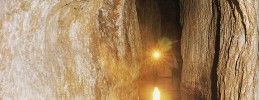
"Fantastic Experience!"
"unbelievable week in israel", "great family private tour", "flawless tour of israel", "lifetime memories", "absolutely fabulous", "trip of a lifetime", "exceptional experience", "amazing trip", "perfect in every way".

Our Group Israel Tours
which tour interests you:?
- 10 Day Israel Adventure
- 12 Day Israel Experience
- 13 Day Israel Tour & Petra
- 15 Days Israel & Petra Tour
- Classic Israel Group Tours
- Israel Tour Packages
- Jewish Heritage Group Tours

Discover the sites
amazing locations…
- Golan Heights Tour SItes
- Israel’s Coastal Sites
- Jerusalem New City Sites
- Jerusalem Old City Sites
- Judean Desert Sites
- Negev Desert Tour Sites
- Tel Aviv & Jaffa Tour Sites
- Tiberias & Jordan Valley SItes

Explore more!
useful info for your trip…
- Advice on Israel Travel
- Business Terms & Conditions
- Professional Israel Tour Guides
- Recommended Reading
- Restaurant in Jerusalem
- Restaurants in Tel Aviv
- Useful Pre-Tour Info

Let’s Go Touring!

- Accessibility decleration
Israel and You Spaces and Places in Israel
The kotel tunnels.
Israel and You May 16, 2014 Attractions , Featured , Jewish Religious Sites , Museums
Review Overview
Tour guide level, suitable for kids, interesting, recommended, number one tour in jerusalem.
The Kotel tunnels is absolutely a must. The mixture of stunning archaeological findings, Top level religious importance and an extremely talented tour guides gives it the crown.
Minharot Hakotel
When I recommend a visit to the Kotel Tunnels, I know what I am talking about. My co-editor of Israelandyou was a guide there for several years. I keep returning to visit the tunnels because of the the feeling I have of tracing the footsteps of my priestly Kohanim forefathers crossing the arch to offer sacrifices in Herod’s Temple. You can experience this yourselves. The tour of the Kotel Tunnels ( or Western Wall Tunnels) is one of the most popular tourist sites in Jerusalem. The tunnels are underground and connect the western wall prayer area to the north-west side of the temple mount, passing along the side of the temple mount and under the present day houses in the Old City. Along its path are remains from the second temple period (Hasmonean and Herodian), as well as structures from later periods. Walking along the tunnels is a tremendous experience like taking a time machine back to the time of the second temple.
The area west of the temple mount connected the temple to the the western side of Jerusalem d uring the second temple period – from the Hasmonean period (2nd C BC) up to the Roman destruction of Jerusalem (70AD). There were four gates located on this side – two gates at a lower level (Barcley and Warren) and two gates on top of bridges (Robinson and Wilson) . A paved street passed at the foot of the temple mount, and additional structures and installations were located at that street level.
After two millenniums, new buildings were built on top of debris accumulated along the western side f ollowing the Roman destruction . However, under these structures, some cavities remained buried deep underground.
British researchers Charles Wilson, in 1864 and Charles Warren, in 1867-1870, uncovered the northern extension of the Western Wall Prayer Plaza. The shafts that Charles Warren dug through Wilson’s Arch can still be seen today.
Immediately after the Six Day War, the Ministry of Religious Affairs began the project of exposing the entire length of the Western Wall. They found enormous courses of distinctively carved stone that were remarkably well preserved. There were also remains of the Herodian road which ran alongside the Temple Mount, ancient cisterns, impressive construction efforts from the Muslim era, and a Hasmonean period aqueduct that had been blocked by Herod’s construction of the Western Wall.
The southern most part of the Kotel is within the Davidson Museum. To the north an open air area is reserved for women. Further north another open air area is reserved for men. A prayer tunnel was excavated uner Wilson’s Arch north of the Kotel and is open to the public, men and women alike, and no entrance fee is required. You can see Wilson’s Arch in the photo below.

The tourist site was fully opened in 1996, with 500m long tunnel along the north-western wall. The route of the tunnel tour starts from the entrance on the north side of the western wall prayer area, and ends at Station No. 1 of the Via Dolorosa. Since there is a limit in the number of visitors that can join a tour, an appointment should be made well in advance.
http://youtu.be/FyRoKoJW-9s
(a) Secret passage

During the Roman period, one of the western entrances to the temple mount was over a bridge which is now called the Wilson arch, which is located on the north side of the Western Wall prayer area. It is described by Josephus on several occasions: the description of the attack by Pompey in 63BC (Wars 1 7 2): “Aristobulus’s party was worsted, and retired into the temple, and cut off the communication between the temple and the city, by breaking down the bridge that joined them together”. The bridge was destroyed during Titus’s attack in 70AD (Wars 6, 6 2): “…a bridge that connected the upper city to the temple”. It was later repaired by the Romans in the 2nd or 3rd C after may have established a Roman temple Jupiter on the temple mount. The bridge was repaired in the 7th C by the Arab rulers, who connected the west side of the city to the temple mount for easier access to their new Al-Aqsa and Dome of the Rock mosques. The present day Chain street (Silsila) actually passes on its upper side. The cavity below the street was termed “the secret passage” in the middle ages. It stretches along 70m – from the Hagai (Al-Wad) street on the west to the temple mount on the east. This “secret passage” serves today as the entrance to the underground tour.
(b) Second Temple period stairs

The area around the “secret passage” is still undergoing excavations. The archaeologists revealed second temple period stairs and other ancient findings.
(c) Large Hall and Model

North to the Wilson arch and bridge is a large underground cavity called the “large hall”. Its high ceiling allows a great view of the hidden western wall. A model of the second temple is located on the west side of the hall, in front of a set of benches. This area is temporarily closed. The tour guide describes the story of the temple mount with the assistance of the model, which uses the electrical controlled mechanism to demonstrate the phases of its construction by Herod.
(d) Western Wall – section
On the eastern side of the great hall are remains of the lower side of the Herodian Western wall. The base stones are incredibly huge – the largest one – seen below – is 14m wide and 4m high, and weighs 600Tons!

There is no cement holding the stones together; only their weight and the perfect match between the stones made them hold firmly together. Each layer of rock recedes several centimeters to help withstand the enormous pressure of the temple mount over two millenniums. The rectangular holes in the stone were added in the middle ages. Their purpose was to hold the plaster which was applied onto the walls, when this section was transformed into a water reservoir.
(e) Warren’s gate (facing the Holy of Holies)
This underground gate, unfortunately now sealed, is located 40m north of the Wilson arch. Warren’s Gate is now underground, but it was at ground level when built by Herod the Great. You can see the wall sealing the gate in the photo. The entrance here is located at the bottom of the temple mount ancient walls, at a depth which was the street level during the second temple period. The opening of this gate faces the Holy of Holies structure and the foundation stone, and therefore is considered the holiest gate. It was discovered in 1867 by Charles Warren.

(f) Opposite the Foundation stone
The foundation stone (Hebrew: Even Ha-Shtiya, from the word “Tashtit”), also known as “The Rock” (Hebrew: Ha-Sela), was the heart of the Holy of Holies. According to Jewish tradition, the rock marks the center point of God’s dwelling and the creation of the world and the site of Isaac’s Sacrifice. Some traditions and archaeologists locate it in the center of the Dome of the Rock, which is located beyond the wall, although there are other suggested locations around the temple mount. The Jewish women come to pray here in the niche of the “opposite foundation stone”, or in other locations along the wall.
(g) Medieval Cistern
Along the western wall is a medieval period cistern.
(h) Western Wall tunnel
During the excavations and preparation of the western wall tunnel tour (1980s and 1990s), a modern tunnel was constructed along the base of the wall (several dozens of meters long) at the Roman street level. It supports the old city structures above it, which were built above the Roman street level during the Medieval periods. A large number of large stones were found laying around the Roman paved street. They were thrown from the temple above into the street by the Roman soldiers, during the leveling of Jerusalem, after it was captured and burnt. This evidence of destruction was also found in the South-West Wall excavations.
(i) Dressed Bedrock Begins – Kotel Tunnels
On the north side of the temple mount, the builders of the temple mount had to cut away the bedrock. The original topography of the Moriah mountain on the north-west corner was higher than the temple mount, and so the engineers had to remove some of the rock in order to expand the temple mount during the Herodian period expansion. The side of the exposed rock was chiseled and dressed to look like the pillars on the south side.

(j) Hasmonean Cistern
The western section of a Hasmonean period cistern was located at this section.
(k) Ancient Guardrail
A large stone was found that served as a guardrail on the edge of the ancient street. It protected the people from falling into the open trench, which was used to collect rain water from the street.

(l) Second Temple period street
The Roman street stretched along the western wall, from the north to the south. A section of a second temple period (Herodian) paved street was found in this section. Only a small section of the street was uncovered.A pair of columns, part of the colonnaded street, are seen on the edge of the street. As in the Cardo Maximus street, shops were located along the street along the side of the wall.
The section near the Herodian street was part of a stone quarry, which prepared stones for the western wall.

(n) Hasmonean Water Tunnel
The tunnel traverses the path of a Hasmonean period aqueduct. It supplied water from the north side of the city, filling up the cisterns under the Hasmonean citadel, Antonia, which was located on the north side of the temple mount. The water channel was cut off during the Herodian period when the temple mount was enlarged to the north.

(o) Ancient Pool – Kotel Tunnels
At the northern edge of the tour is an ancient water reservoir called the Struthion Pool. The meaning of the Latin word is “sparrow”. This large reservoir collects the winter rain water from the rooftops in order to supply water during the dry summer season. Initially it was an open pool, built by the Hasmoneans, and mentioned by Josephus in his accords of the siege of Jerusalem (Wars 5 11 4 ): “For there were now four great banks raised, one of which was at the tower Antonia; this was raised by the fifth legion, over against the middle of that pool which was called Struthius”. The pool was later covered by the Romans in the 2nd C.The Struthion pool is located at the basement of the Notre Dame De Sion (Ecce Homo) monastery. The initial plan of the tunnel tour was to exit through the monastery, but this was not accepted by the order. Alternatively, the exit of the tour was diverted to a modern opening through the pool, located near the first station of Via Dolorosa.

During a fascinating tour of the Western Wall Tunnels – Hidden layers of the Wall are revealed underground. They tell the story of ancient Jerusalem and of generations of longing for it.
Did you meet ancestors as you traced the Western Wall of the Holy Temple?
The tour takes approximately an hour and 15 minutes. Opening hours:
Sunday – Thursday: 7am – evening (depending on reservations). Fridays and on the eve of festivals: 7am – 12pm
The site is closed on Shabbat and festivals, and on the eve of Yom Kippur and Rosh Hashana, and on Tisha B’av. On Chol Ha’moed the site is open as usual (with a reservation and payment).
The hotline (02-6271333) is operational between 8:30 – 17:00.
Visitation of the site is only through guided tours which must be ordered in advance. It is recommended that you book two months in advance. To receive your ticket – bring the credit card with which you made your order.
The Generations Center is accessible for all kinds of handicaps. Please speak with our representative about this so that we will be able to give you the best possible service and assistance.
Tours are given in English and in Hebrew. During the month of August tours are given in French as well. For reservations in French call 02-6271333 group tour reservations (line no. 1).
Fees for individuals and for groups using a guide from the Western Wall Heritage Foundation:
- Adult: 30 shekels
- Student / Soldier / Security officer: 15 shekels
- Child (Age: 5-18) / Senior citizen / Handicapped: 15 shekels
Fees for groups with their own guide:
- Adult: 25 shekels
- Student / Soldier / Security officer: 10 shekels
- Child (Age: 5-18) / Senior citizen / Handicapped: 10 shekels
Been there, Done that? leave a comment!
Share this:, about israel and you, related articles.

Umm al Fahm Art Gallery *
June 13, 2022

Siebenberg House *
May 23, 2022

Harry Oppenheimer Diamond Museum *
May 17, 2022

The Egged History Center *
May 3, 2022

Bible Lands Museum *
April 28, 2022

Qassam Museum in Sderot *
March 21, 2022
City of David and Hezekiah's Tunnel
- Facilities 3.0
- Atmosphere 4.0
The City of David, founded more than 3,000 years ago by King David, serves as a major archeology site and a functioning residential neighborhood within the Old City . Visitors explore what remains of this ancient city (which includes what's left of the First and Second Temples), both above ground and below. Before you start your exploration, stop in at the visitor's center (located just outside the Jewish Quarter's Dung Gate), where you'll find information on City of David sites and guided tours.
For most visitors, the highlight of a City of David visit is Hezekiah's Tunnel. The tunnel was ancient Jerusalem's primary source of water, according to the Bible. Today, you can traverse this ancient waterway, an amazing feat of ancient engineering. One TripAdvisor warns, "This is pretty strenuous and can be damp, so wear proper clothing and shoes."
During the winter, you can explore the City of David and Hezekiah's Tunnel from 8 a.m. to 5 p.m. Sunday through Thursday, and from 8 a.m. to 2 p.m. on Friday. During the summer, the site stays open from 8 a.m. to 7 p.m. Sunday through Thursday and from 8 a.m. to 4 p.m. on Fridays. The City of David closes its doors on Saturdays and major Jewish holidays. Admission ranges from 27 to 35 ILS ($7 to $9.20 USD) for adults, depending on which tour you choose. For more information, visit the City of David website .
Popular Tours

Jerusalem : Private Walking Tour with A Guide (Private Tour)
(11 reviews)
from $ 108.60

Masada and the Dead Sea Day Trip from Jerusalem
(747 reviews)
from $ 111.00

Old and New Jerusalem Full-Day Tour
(270 reviews)
from $ 75.00
More Best Things To Do in Jerusalem

#1 Old City
Chances are that you'll spend much of your time here. The Old City is home to many of Jerusalem's most sought-after attractions, including the Western Wall, the Church of the Holy Sepulchre, and Temple Mount. Originally built by King David in 1004 B.C., the walled Old City comprises four distinct areas: the Jewish Quarter (or the Cardo), the Muslim Quarter, the Christian Quarter, and the Armenian Quarter. Each quarter exudes its own unique atmosphere, with religious sites, shops, and food offerings reflecting its respective heritage. Yet the Old City's winding alleyways and ancient stone plazas allow mixing and mingling among these cultures, making a very eclectic environment.
It's easy to lose yourself (both metaphorically and geographically) in the Old City, but make sure you devote some attention to its boundaries. You can access the Old City from seven entryways: the New Gate, Damascus Gate, Herod's Gate, Lions' Gate, Dung Gate, Zion Gate, and Jaffa Gate. Each doorway marks a significant era of Jerusalem's history. For example, Jaffa Gate is where the Tower of David (the city's primary defense point) can be found.
Explore More of Jerusalem

Things To Do

Best Hotels

You might also like

# 5 in Best Cheap European Vacations for 2023-2024

# 9 in Best Places to Visit in Africa in 2023

If you make a purchase from our site, we may earn a commission. This does not affect the quality or independence of our editorial content.
Recommended
The 18 Best Napa Valley Wineries to Visit in 2024
Lyn Mettler|Sharael Kolberg April 23, 2024

The 25 Best Beaches on the East Coast for 2024
Timothy J. Forster|Sharael Kolberg April 19, 2024

The 50 Best Hotels in the USA 2024
Christina Maggitas February 6, 2024

The 32 Most Famous Landmarks in the World
Gwen Pratesi|Timothy J. Forster February 1, 2024

9 Top All-Inclusive Resorts in Florida for 2024
Gwen Pratesi|Amanda Norcross January 5, 2024

24 Top All-Inclusive Resorts in the U.S. for 2024
Erin Evans January 4, 2024

26 Top Adults-Only All-Inclusive Resorts for 2024
Zach Watson December 28, 2023

Solo Vacations: The 36 Best Places to Travel Alone in 2024
Lyn Mettler|Erin Vasta December 22, 2023

26 Cheap Beach Vacations for Travelers on a Budget
Kyle McCarthy|Sharael Kolberg December 4, 2023

The 50 Most Beautiful White Sand Beaches in the World
Holly Johnson December 1, 2023

- Tours and Activities
- Accommodation and camping
- Activities for groups
City of David National Park
- The Farm In the Valley
- Mount of Olives
- Armon Hanatziv
- Emek Tzurim National Park
- The Peace Forest
- Kidron Valley
- News in Antiquities
- Celebrating
- About City of David
Cart is empty
Ancient Jerusalem Tours
Hallelujah night show.
The popular night show offers visitors a a unique light show projected onto the antiquities with pyrotechnics that combine effects of fire and water.
Duration: 0:40 hours
From 45 NIS per ticket (Ticket prices may vary depending on discounts and ticket selection)
City of David VR
An exclusive Virtual and Augmented Reality experience that places you in the thick of the action!
Duration: one hour
From 55 NIS per ticket (Ticket prices may vary depending on discounts and ticket selection)
The Archaeological Experience
Uncover treasures from archaeological excavations in the City of David and Ancient Jerusalem and become archaeologists for a day!
Duration: an hour and a half
From 21 NIS per ticket (Ticket prices may vary depending on discounts and ticket selection)
Guided Segway Tour
Come and enjoy a guided Segway tour where you can experience Jerusalem in a new way: between beautiful views, away from traffic and traffic jams
Duration: 2 hours
From 159 NIS per ticket (Ticket prices may vary depending on discounts and ticket selection)
Come and discover Jerusalem’s secrets: Look out over the horizon of ancient Jerusalem, and walk underground among the shafts to Jerusalem’s ancient spring.
From 14 NIS per ticket (Ticket prices may vary depending on discounts and ticket selection)
Western Wall Cornerstone
You're invited to travel back in time 2,000 years, to the hidden world under the giant stones of the Western Wall.
From 42 NIS per ticket (Ticket prices may vary depending on discounts and ticket selection)
The Biblical City of David
Walk in the footsteps of the kings and prophets, through underground passageways and in the waters of the Siloam tunnel (Hezekiah’s tunnel) by flashlights.
Duration: 3 hours
Blue stone path
We welcome you to come visit the underground Hasmonean Water Tunnel.A station directing you to the tour awaits you at the Haas Promenade at Armon...
From 15 NIS per ticket (Ticket prices may vary depending on discounts and ticket selection)
Is anyone here?
Since the system has not been used for some time, an automatic logout will occur in - 03:00 minutes
אופס, משהו השתבש...
.לא הצלחנו לסיים את תהליך הרכישה ניתן לחזור לסל הקניות ולנסות שוב :או ליצור איתנו קשר
טלפון נייד *
- Travel/Study

BIBLE HISTORY DAILY
Hezekiah’s tunnel reexamined.
The dates assigned the Siloam Inscription and Jerusalem tunnels are questioned

A young boy wades through Hezekiah’s Tunnel, the most famous of the Jerusalem tunnels. The image brings to mind the discovery of the Siloam Inscription—located at the southern end of Hezekiah’s Tunnel—by a youth in 1880. Photo: Hershel Shanks.
Hezekiah’s Tunnel, part of Jerusalem’s water system, is located under the City of David. It connects the Gihon Spring—Jerusalem’s fresh water supply—with the Siloam Pool . According to 2 Chronicles 32:2–4 and 2 Kings 20:20, this tunnel was dug during the reign of King Hezekiah of Judah to prepare Jerusalem for the imminent attack of the Assyrian king, Sennacherib . In the Bible, Hezekiah redirected the water through old and newly dug Jerusalem tunnels. However, many have wondered if Hezekiah’s Tunnel was actually dug by Hezekiah at the end of the eighth century B.C.E. (Iron Age II). In the September/October 2013 issue of BAR , editor Hershel Shanks reviews the evidence for the dating of the Jerusalem tunnels in “ Will King Hezekiah Be Dislodged from His Tunnel? ”
The first argument for re-dating the tunnel concerns the Siloam Inscription. Found at the southern end of Hezekiah’s Tunnel, the Siloam Inscription recounts how the men digging the tunnel worked in two directions—one from the north, the other from the south—and met in the middle. The Siloam Inscription does not name Hezekiah or Sennacherib I, the Sennacherib in the Bible, which would simplify matters. While most scholars attribute the Siloam Inscription to the Iron Age II, John Rogerson and Philip Davies argue that it is actually Hasmonean , which raises the question: Which period is a better fit for the Siloam Inscription?
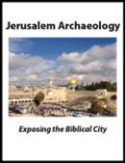
FREE ebook: Jerusalem Archaeology: Exposing the Biblical City Read about some of the city’s most groundbreaking excavations.

As described in the Siloam Inscription, Hezekiah’s Tunnel was dug by two teams, who worked in opposite directions and met in the middle, to prepare for the invasion of Sennacherib. In the Bible, this impressive feat is detailed in 2 Chronicles 32:2–4.
The second argument concerns the amount of time it would have taken to dig Hezekiah’s Tunnel. Based on the type of rock in Jerusalem tunnels, geologists Amihai Sneh, Eyal Shalev and Ram Weinberger contend that Hezekiah’s Tunnel could have been hewn in no less than four years. Did Hezekiah have time to dig the tunnel before the arrival of Sennacherib? In the Bible, it does not specify the amount of time between the threat of attack and the siege itself, but Assyrian records shed light on the matter. (In the Bible History Daily web-exclusive discussion Regarding Recent Suggestions Redating the Siloam Tunnel , leading archaeologists Aren Maeir and Jeffrey Chadwick propose that Hezekiah had ample time to construct the tunnel during the revolt against Assyria.)
The final argument hinges on the relationship of the various channels of the water system in Jerusalem. Tunnels were dug in very different periods, ranging from the Middle Bronze Age to the Second Temple period.
Ronny Reich and Eli Shukron, who have excavated the City of David near the Gihon Spring extensively, believe that the starting point of Hezekiah’s Tunnel was Tunnel IV, which is connected to the Round Chamber of the Rock-cut Pool. At the entrance to Tunnel IV from the Rock-cut Pool there is a place that had been smoothed for a plaque. The similarity between this plaque and the Siloam Inscription supports the idea that Tunnel IV marked the beginning of Hezekiah’s Tunnel, just as the Siloam Inscription marked its end.
A house built on top of rubble fill, which blocked the entrance to Tunnel IV, was found in the Round Chamber. Some of the pottery in the fill under the house dates to the late ninth–early eighth century B.C.E. (Iron Age IIa)—which predates the time of Hezekiah by nearly a hundred years. Based on this pottery, Reich and Shukron date the house to the late ninth or early eighth century B.C.E. as well.
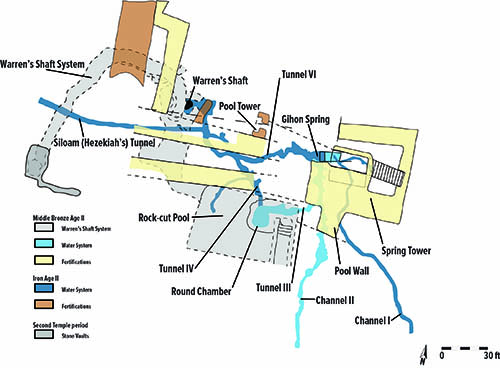
In Jerusalem, tunnels—numerous and crisscrossing—of the water system are difficult to keep straight, but through their excavations in the subterranean levels of the City of David, Ronny Reich and Eli Shukron have mapped out the Jerusalem tunnels. The Siloam, or Hezekiah’s, Tunnel connects to the Gihon Spring via Tunnel VI. Reich and Shukron believe that the starting point of Hezekiah’s Tunnel was in Tunnel IV.
According to the rules of deposition, Tunnel IV and Hezekiah’s Tunnel had to predate this house since debris underneath the house were used to block Tunnel IV. Additionally, if the two channels had not been dug, water would have continued to flow into the Rock-cut Pool, and the house would have been underwater. On this basis, Reich and Shukron argue that Tunnel IV and Hezekiah’s Tunnel must have been constructed by one of Hezekiah’s predecessors, dating as early as the time of King Jehoash (835–801 B.C.E.)—a century before Sennacherib’s siege of Jerusalem in 701 B.C.E.
Is Jehoash actually responsible for “Hezekiah’s” Tunnel?
—— Subscribers : Read Hershel Shanks’s full article “ Will King Hezekiah Be Dislodged from His Tunnel? ” by BAR as it appears in the September/October 2013 issue of Biblical Archaeology Review .
Read more in Bible History Daily :
Hezekiah’s Tunnel
Hezekiah’s Tunnel Revisited
Ancient Reservoir Provided Water for First Temple Period Jerusalem
This Bible History Daily feature was originally published on August 23, 2013.
Get more biblical Archaeology: Become a Member
The world of the Bible is knowable. We can learn about the society where the ancient Israelites, and later Jesus and the Apostles, lived through the modern discoveries that provide us clues.
Biblical Archaeology Review is the guide on that fascinating journey. Here is your ticket to join us as we discover more and more about the biblical world and its people.
Each issue of Biblical Archaeology Review features lavishly illustrated and easy-to-understand articles such as:
• Fascinating finds from the Hebrew Bible and New Testament periods
• The latest scholarship by the world's greatest archaeologists and distinguished scholars
• Stunning color photographs, informative maps, and diagrams
• BAR's unique departments
• Reviews of the latest books on biblical archaeology
The BAS Digital Library includes:
• 45+ years of Biblical Archaeology Review
• 20+ years of Bible Review online, providing critical interpretations of biblical texts
• 8 years of Archaeology Odyssey online, exploring the ancient roots of the Western world in a scholarly and entertaining way,
• The New Encyclopedia of Archaeological Excavations in the Holy Land
• Video lectures from world-renowned experts.
• Access to 50+ curated Special Collections,
• Four highly acclaimed books, published in conjunction with the Smithsonian Institution: Aspects of Monotheism, Feminist Approaches to the Bible, The Rise of Ancient Israel and The Search for Jesus.
The All-Access membership pass is the way to get to know the Bible through biblical archaeology.
Related Posts
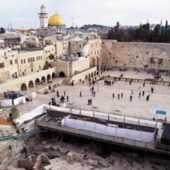
Ancient Jerusalem: The Village, the Town, the City
By: Hershel Shanks
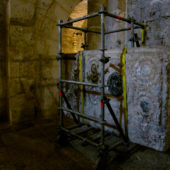
The Ancient Altar from Jerusalem’s Church of the Holy Sepulchre
By: Nathan Steinmeyer
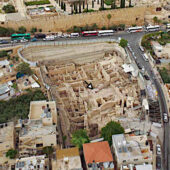
Biblical “Chamber” Identified in Jerusalem?
By: Marek Dospěl

Did Jesus’ Last Supper Take Place Above the Tomb of David?
26 responses.
An observation upon reading 2 Kings 20: v. 20 and 2 Chronicles 2: vs. 2-5: I don’t read that Hezekiah built the tunnel before the siege of Sennacherib as is being assumed here. All these passages say is that Hezekiah and the people blocked off the springs before Sennacherib arrived so that the Assyrians wouldn’t find abundant water. He may have built the tunnel after the siege which would have allowed him much more time. Why is it assumed that he built the tunnel quickly before the siege? Scripture never tells us he did this. Am I missing something?
They probably got the “fill” from the city dump (read Kidron Valley).
Awesomeness
Mark writes: “Thus the tunnel has to be older then the fill, if the fill was used to block the tunnel so-as the house would not flood and be under water.”
Your assumption here is that the fill material itself dates to the time of deposition of the fill in the tunnel. But fill material would probably have been old sherds and debris that the workmen would have had no problem disposing of as a means to block the tunnel. Think about it. There are old churches in Greece incorporating (i.e. reusing) stones that had been part of structures dating to the pagan era of ancient Greece hundreds of years before the arrival of Christianity in Greece. Does that mean that the church itself was built in, say, 200 BCE, simply because the oldest stone used in its construction dates to that time?
There is evidence to suggest that the tunnel was built to divert water into the first temple which was built by Solomon in the City of David (not Jerusalem). The water was used for the priest’s ritual bath (Mikveh) and to clean the alter after sacrifices. I believe the Temple Mount was actually the Roman fortress. Josephus reported that the Roman built a 600′ dual-bridge between the southern wall of the fortress and the Temple so the soldiers could quickly get from their positions to the temple if needed. 600′ south of the Temple Mount puts you right over Hezekiah’s Tunnel which was likely in the middle of the temple.
I’m new to this site, and I must say how wonderful the discussions are, by all of you. You’re all insightful and intelligent, and l thoroughly enjoy time spent here…
I’m just so inspired of it all.
Did King Hezekiah really build a tunnel into Jerusalem?
Hezekiah was a king of Judah in the late eighth century B.C.E., a time of conflict with the mighty Assyrian power. The Bible tells us that he did a great deal to protect Jerusalem and to secure its water supply. Among the works he undertook was the construction of a 1,749-foot-long [533 m] tunnel, or conduit, to bring springwater into the city.—2 Kings 20:20; 2 Chronicles 32:1-7, 30.
In the 19th century, just such a tunnel was discovered. It became known as Hezekiah’s Tunnel, or the Siloam Tunnel. Inside the tunnel, an inscription was found that described the final phases of the tunnel’s excavation. The shape and form of the letters of this inscription lead most scholars to date it to the time of Hezekiah. A decade ago, however, some suggested that the tunnel was built about 500 years later. In 2003, a team of Israeli scientists published the results of their research aimed at fixing a reliable date for the tunnel. What conclusion did they reach?
Dr. Amos Frumkin of the Hebrew University of Jerusalem says: “The carbon-14 tests we carried out on organic material within the plaster of the Siloam Tunnel, and uranium-thorium dating of stalactites found in the tunnel, date it conclusively to Hezekiah’s era.” An article in the scientific journal Nature adds: “The three independent lines of evidence—radiometric dating, palaeography and the historical record—all converge on about 700 BC, rendering the Siloam Tunnel the best-dated Iron-Age biblical structure thus far known.” http://wol.jw.org/en/wol/d/r1/lp-e/1200272697
So here we go again, as President Ronald Reagen used to say. Or something to that effect. At any rate about 15 years ago, a paper was published in the journal, Science, by two archaeologists from Hebrew U. They were trying to date when the tunnel was built based upon carnon dating, flora etc. Guess what? Their results were the same as written in the Tanach. By Chizkayahu. End of story.
An article in the scientific journal Nature adds: “The three independent lines of evidence—radiometric dating, palaeography and the historical record—all converge on about 700 BC, rendering the Siloam Tunnel the best-dated Iron-Age biblical structure thus far known.”
http://www.biblicalarchaeologytruth.com/hezekiahs-tunnel.html … Show s that the book by Ronny Reich’s Excavating the City of David went overboard easily explaing the house on top information does put the tunnel to Hezekiah time.
Concerning Ronny Reich’s Excavating the City of David … Time for a book burning event!
How com you don’t look at Dr. Amos Frumkin of the Hebrew University of Jerusalem set out in 2003 to to get a reliable date by carbon-14 … the result put it right at Hezekiah Time. The book is by Ronny Reich’s Excavating the City of David is worthless!
Just how many idiots out there will try to discredit the Bible?
I agree. Scientist do not always get things right. If it is written in the Bible which is God’s word that is good enough for me. With God’s help everything can be done.
yeah i support what the 7th person explained,on my own side i see no reason to argue what is in the bible,because if they where not real then,it will not be there.
[…] city wall, inside the city to a pool on the opposite side of the ridge. In the years that followed, “Hezekiah’s Tunnel” continued to carry fresh water to this section of Jerusalem, and different pools were built here […]
[…] Seven Lean years tradition, Shalmaneser’s Black Obelisk, Shishak’s Geographical Lists, Siloam Inscription, Sinuhe’Story, Tale of Two Brothers, Wenamun’s […]
Another possibility is that some earlier kings had set out on this task before Hezekiah — [we know the Canaanites had already dug their own tunnel to the Gihon] — only for these kings to find it too costly to see it through to completion. Perhaps, Hezekiah was the first king to have the resources and the impending need to see this project to its end. This would resolve issues of rubble and pottery that predate King Hezekiah, which may exist due to earlier, failed attempts. It also helps with the time-frame of finishing the project, if say, the project was already a third of the way complete when Hezekiah took over. (Just a thought).
Sounds to me like someone just wants to try moving the dates. Do you people seriously think ancient scribes would write of a certain king (Hezekiah) building a tunnel in their most beloved book (to be read by other ancient people of the time), if it were not so? Anyone of ancient times would have known better, and would have also known who had it built.
It’s quite common in building practice today to use excavated material from one site as fill in another; it’s cost-effective and efficient. If, as the article seems to suggest, the fill was used as foundational material for the structure (not derived from the structure), it’s not unreasonable to suppose the fill could include material that pre-dates the tunnel.
Saundra, you make a very good point about dating areas by pottery: since the occupants could have kept generational family heirlooms (pottery) for possibly century’s. However, in this instance the pottery that was dated was found in the fill used as the foundation for the home and not part of the housewares thereof. Quoting the article, “Some of the pottery in the fill under the house dates to the late ninth–early eighth century B.C.E. (Iron Age IIa)—which predates the time of Hezekiah by nearly a hundred years.” Thus the tunnel has to be older then the fill, if the fill was used to block the tunnel so-as the house would not flood and be under water.
I would think that preserving pottery for several generations would be the norm in ancient times. It is only in recent centuries that we have become a throw-away society
Is it plausible that people in the 8th century BCE would preserve pottery from centuries earlier?
Dating based on the oldest piece of pottery found seems to forget one ancient human custom. I have several artifacts in my home from ancestors several generations back. If a tornado destroyed my home and they based it on the oldest evidence in the pile, they would be off by more than a hundred years of the correct date of my home. “Some” pieces dating to an earlier period could be treasured family heirlooms of the homeowner kept for may years.
Write a Reply or Comment Cancel reply
Your email address will not be published. Required fields are marked *
Recent Blog Posts
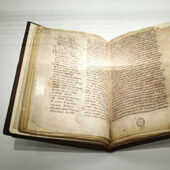
Text Treasures: The Pilgrimage of Egeria

Ancient Samaria and Jerusalem

What Did Gladiators Eat?
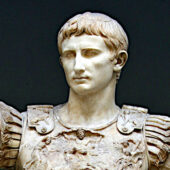
Has the Site of Augustus’s Death Been Discovered?
Must-read free ebooks.
50 Real People In the Bible Chart

The Dead Sea Scrolls: Past, Present, and Future

Biblical Peoples—The World of Ancient Israel

Who Was Jesus? Exploring the History of Jesus’ Life
Want more bible history.
Sign up to receive our email newsletter and never miss an update.
By submitting above, you agree to our privacy policy .
All-Access Pass
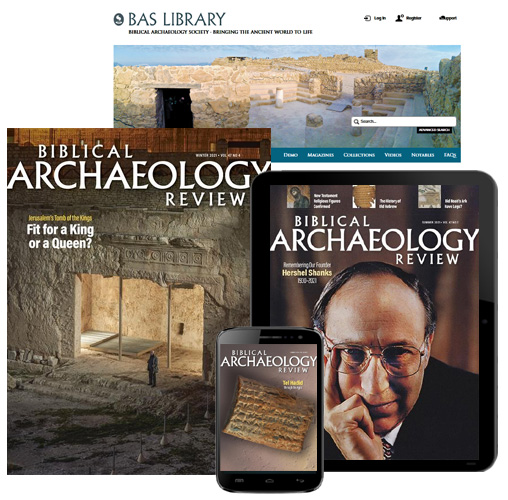
Dig into the world of Bible history with a BAS All-Access membership. Biblical Archaeology Review in print. AND online access to the treasure trove of articles, books, and videos of the BAS Library. AND free Scholar Series lectures online. AND member discounts for BAS travel and live online events.
Signup for Bible History Daily to get updates!

- Solidarity Tours
- Testimonials

City of David – Of Kingdoms and Water – Part II
A tour of the city of david.
Given by Jon C. , written by Deena Levenstein

Our tour of ancient Jerusalem began with a beautiful 360 degree view of eastern Jerusalem and the Old City and then continued to King David’s palace. Read Part I here
From there we continued down, down, down…
Pipes, water tunnels and an abyss
Entire kingdoms and stories are built around water sources. Where there’s water, there is potential for civilization. And so we headed down to see the Gihon Spring, the major water source in ancient Jerusalem, and hear how it was used and manipulated in order to win wars.
King David send Joab up an abyss
In 996 BCE King David decided to capture the Jebusite city that stood in this place. He did it for political reasons – it was the border between the Benjamin and Judah territories – and because of the important water source in the Kidron Valley.
And David said, “Whoever smites the Jebusites first will be a chief and an officer,” and Joab the son of Zeruiah ascended first and became a chief. – Divrei Hayamim I, 11, 6
Ascended where?
And David said on that day; “Whoever smites the Jebusites and reaches the tower [tzinor]…” – Samuel II, 5, 8
The word “tzinor” means “pipe” or “abyss.” But what does it mean in our story?
It was through the water system that King David thought to capture the city. And it was a brave (or crazy – the two are often not easily distinguishable) Joab who agreed to go up the “tzinor” into the Jebusite city.
We headed down many steep metal stairs to see what we could see.
First Jon showed me Warren’s Shaft, a deep hole found by British engineer Sir Charles Warren in 1867.

Warren speculated that this was the tzinor that Joab climbed. This seemed unlikely, Jon explained, since even contemporary IDF soldiers with modern gear could barely make it up the shaft when they tried. And yet there was no better theory to contest Warren’s shaky one.
Until 1995 when a large abyss was found, a few meters from the shaft. The abyss is a large pool (today it is empty) with a hole leading down to the Canaanite Tunnels below.
This, Jon explained, makes much more sense. Abyss is the better translation from biblical Hebrew and it would be much easier to climb than Warren’s Shaft.
I stood there trying to imagine an army 3,000 years ago, climbing up into the city right where I was standing. Amazing!
King Hezekiah’s engineering feat
We continued down further to the Canaanite Tunnel which used to carry water out to the local fields for irrigation.

From inside the tunnel we could see a hole that leads to the abyss above.
But before walking through the Canaanite Tunnel, I took a peak into Hezekiah’s Tunnel.

Taken from inside Hezekiah’s Tunnel:

So, what is Hezekiah’s Tunnel?
Hezekiah reigned during the First Temple period, from around 715-686 BCE in Jerusalem. In 701 BCE Assyria captured most of the surrounding areas and was headed toward Jerusalem. Preparing for the impending siege, Hezekiah made a decision that changed the course of history for the Jewish people.
He decided to divert the water so that instead of having to leave the walls of the city to get water, it would be directed to a pool inside the city walls. This would allow the residents to survive a siege relatively easily.
He had two groups of workers begin to chisel the stone from each end with the intention of them meeting in the middle.

This inscription from Hezekiah’s time was found inside the tunnel and it describes the event when the men met in the middle.
[The] tunneling [is completed]. And this is the account of the tunneling: While [the hewers were swinging their axe(s)] one (group) towards the other with three cubits yet to be hewn, a man’s voice was heard calling out to his fellow (worker). For there was a zidda (fissure?) in the rock to the right and to the left. And on the day of the tunneling the hewers bore through, one man towards the other, axe upon axe, and the waters flowed from the source to the pool, one thousand and two hundred cubits, and a [hu]ndred cubits was the height of the rock above the heads of the hewers.
In this video you can see what this tunnel looks like – it is very windy and it is quite miraculous that they succeeded in meeting.
The Shiloah pool, the Byzantine pool and more
Of course there was more. A tour to the City of David is rich in stories and archaeological discoveries, with new ones being added to the experience all the time. Here are a few more places we visited:
Thank you Jon!

Jon, my trusted guide, taught me so much during those three hours in the City of David. I got to see a range of findings and discuss Bible, history and archaeology with him.
You can read more about Jon here.
You’re welcome to email me any questions.
Read part I
All photos are by yours truly, Deena Levenstein.

Deena Levenstein
Deena Levenstein is a writer and social-cultural entrepreneur in Jerusalem. She creates and hosts events and runs "Things to do in Jerusalem," a Facebook group of handpicked cultural events in the city. In her spare time she blogs at http://deena.co/.
Subscribe to our newsletter
You may also like.

A Message From Joe Yudin – CEO
Travel to Israel has changed dramatically. When I first got into this business about 20 years ago people wanted to see…
A Message From Joe Yudin
Dear Friend of Touring Israel, As you know, we love keeping you up-to-date on the latest happenings in our part of…

33 Flavors at the Mahane Yehuda Market – Part I
Walking through Jerusalem’s Mahane Yehuda Market with Chef Tali Friedman is like walking through a toy store with a child who has learned the toys off by heart and knows exactly which are his favorites and why.

Dreidel times, for the top that never stops
Ever wondered how the dreidel came to be a Chanukah pastime? Turns out — pun intended — that the spinning top…
A Walk Through An Old-New Land Pt. III
By Joe Yudin I used to wander around Neve Tzedek in the early 1990’s. The buildings were falling apart, the roads…

33 Flavors at the Mahane Yehuda Market – Part II
Read part I of 33 Flavors at the Mahane Yehuda Market here By Deena Levenstein We walked through the seemingly secret…

Yom Hazikaron – For Those We Mourn & Celebrate
This juxtaposition of one of the saddest days in the year to one of the most joyous days is difficult for many and yet makes sense since the way to truly appreciate the amazing fact that we have a state is by looking back at those who made it possible, like Akiva Levy, the Holocaust survivor, and thousands of others.

A meteor-gazing Negev adventure
By Deena Levenstein This week I went down to the Negev, Israel’s largest desert in the south which is sort of in…

Tu B’Shvat – Glorious Trees
Happy is the man that hath not walked in the counsel of the wicked, nor stood in the way of sinners,…
International Phone
North america (toll free).

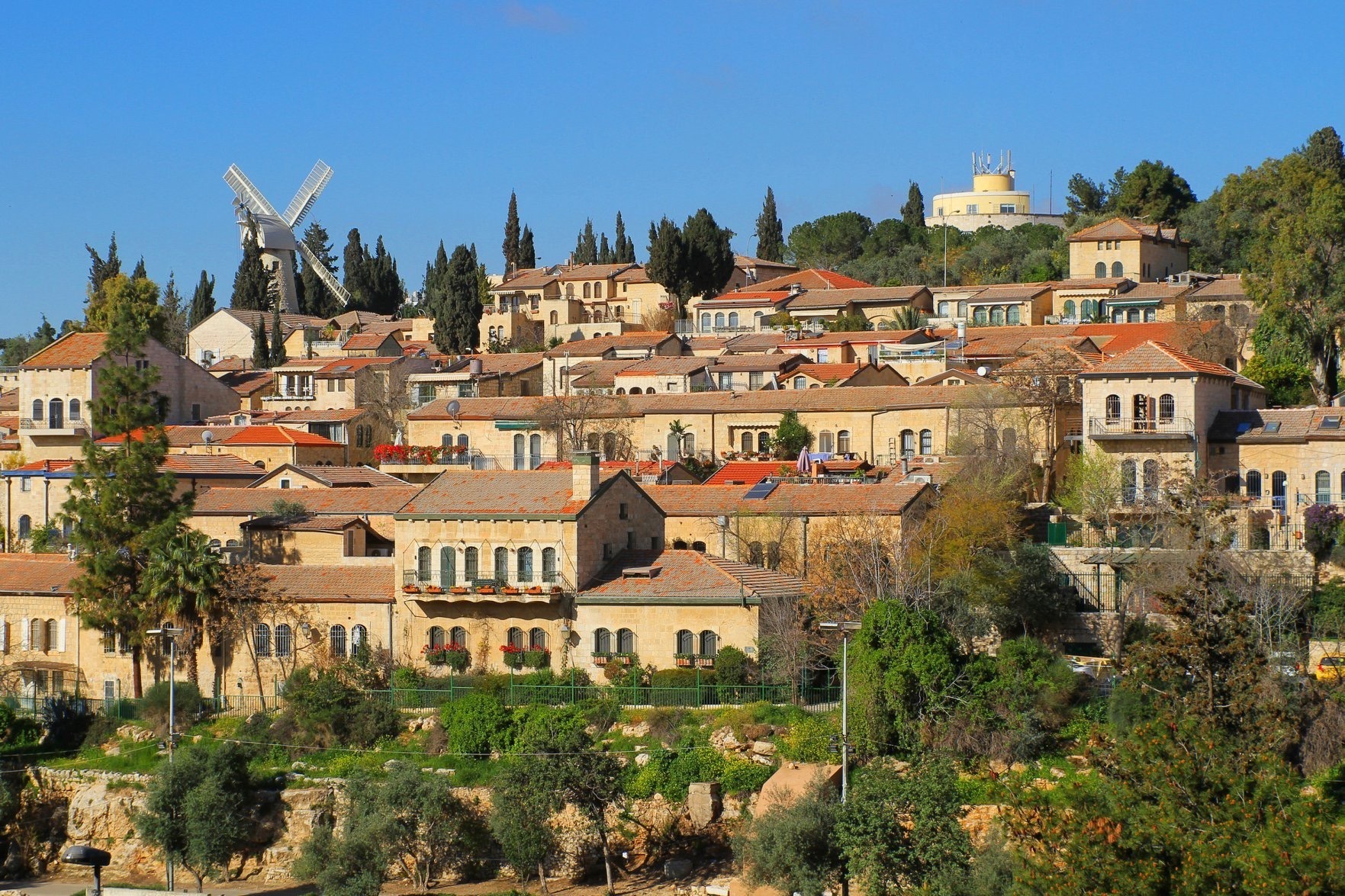
Kotel Tunnel Tours
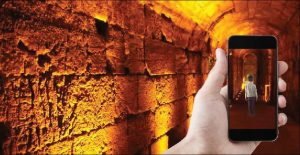
Go underground as you explore the Kotel Tunnels with a trained guide. Learn about the history of this ancient space and it’s connection to religious life in Jerusalem.
The Western Wall of the Temple Mount is one of the most magnificent and significant remnants in Jerusalem from the days of the Second Temple, destroyed approximately 2,000 years ago. Above ground we can only access 70 meters, a small portion of it. Go underground to see the rest.
The Great Bridge Route: NEW!
This tour takes you one more level under the Old City where you will see the Great Bridge that led to the Temple Mount. This route will showcase different rooms and halls that served the people of that time, new and exciting findings, and a first glimpse at newly exposed courses of the Western Wall. You’ll go under the Old City below the tremendous bridge that led to the Temple during the Second Temple period. The route passes exciting sites and findings from the Second Temple period and includes a look at a new exposure of the Western Wall.
The Great Stone Route
Touch the original and special stones that tell the story of the Jewish nation. Visitors to the Western Wall Tunnels walk through ancient and fascinating subterranean spaces with exquisite archeological findings, such as large stone arches, water pits, an ancient water aqueduct that ends at the Strouthion Pool, and more. It includes innovative virtual models and is considered an international attraction. It’s one of the must-see sites in the city of Jerusalem!
A Look into the Past
For the first time in Israel you can take a tour of the Second Temple using advanced VR (virtual-reality) technology. This 360-degree perspective lets you see the beauty of the Temple that was destroyed approximately 2,000 years ago.
The Journey To Jerusalem
Follow in the footsteps of how your family possibly wandered the world – until they returned to the Land of Israel in modern times. A one-of-a-kind experience for people who want to get to know their family history of the past 2,000 years – from the time of our exile from Jerusalem following the destruction of the Second Temple to our return to Jerusalem following its liberation.
The Chain of Generations Center
A visit to this exhibit takes you on the journey taken by the Jewish nation and past generations which form our long and wondrous chain that passes from family to family and from generation to generation.
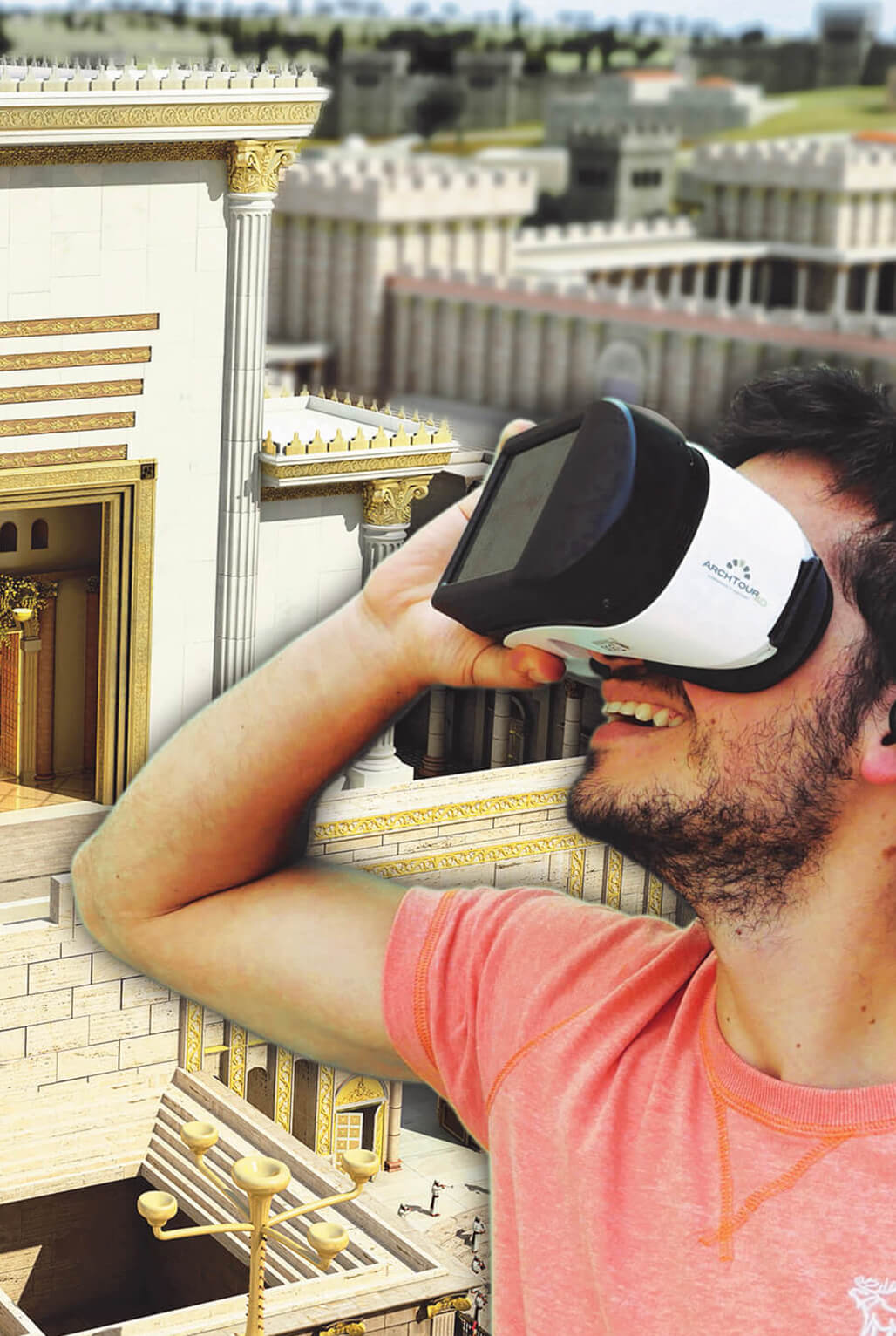
Reservations - Kotel Tunnel Tours
By this vendor.
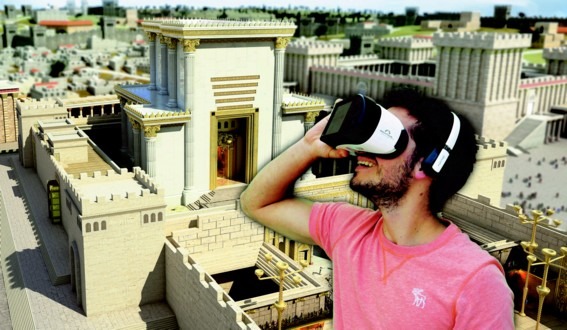
A Look Into The Past – Second Temple VR Experience
Step back in time as you enter the world of the Second Temple period – using Virtual Reality. You will have a 360-degree perspective that lets you see the beauty of the Temple that was destroyed approximately 2,000 years ago. During the visit, you will put on a special set of goggles that will take […]

Upcoming Events
Bloc climbing, go back in time on the time elevator, dead sea bike rides, latest posts.

Yeshiva Week – What’s Happening in Jerusalem
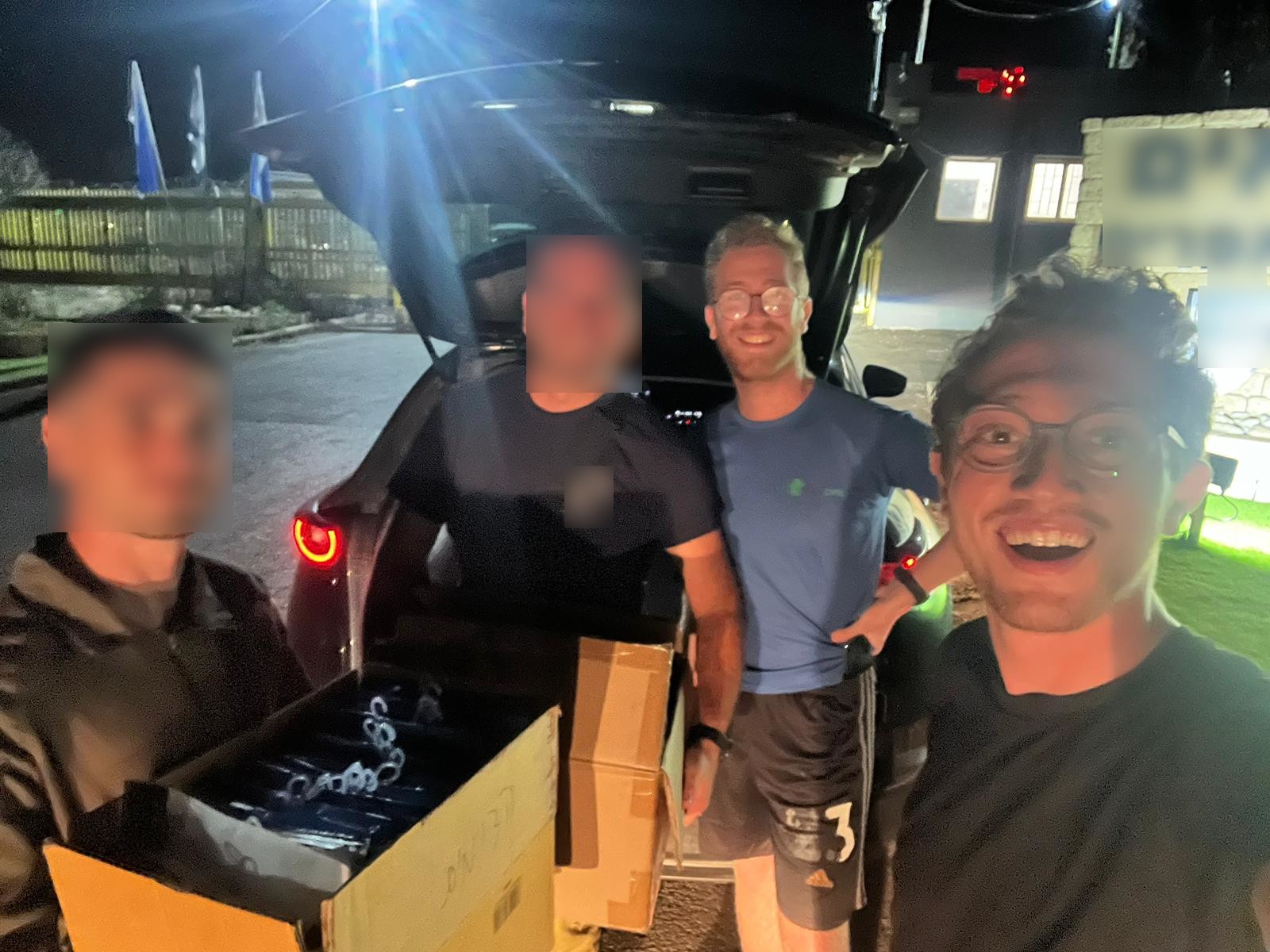
How can you & your children volunteer and help Israel during the war?
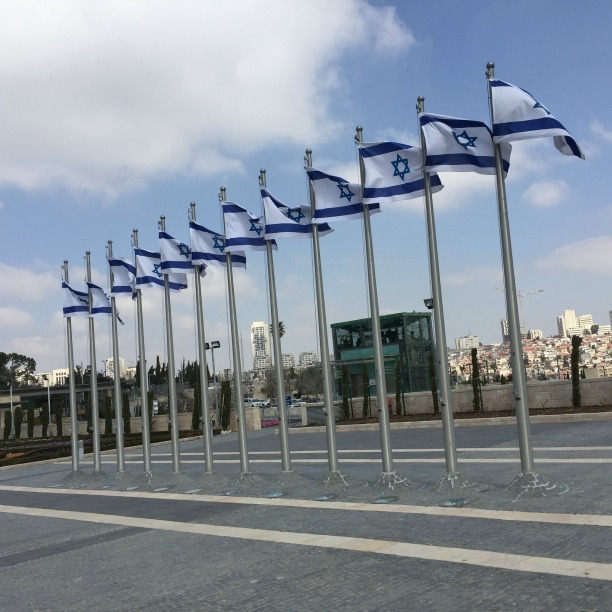
A United Front in-and-around Jerusalem during the War

The Western Wall Tunnels Video Tour
Jerusalem.com takes you to the underground tunnels to explore Jerusalem 2000 years ago in the days of the Second Temple. These mysterious tunnels revealed roman roads, shops and unique building skills which remained since the days of the bible. The Western Wall Tunnels, or Kotel Tunnels, pass underneath the Muslim Quarter and are today the closest one can get to where once stood the ‘Holy of Holies’ on the Temple Mount.

Western Wall Tunnels - Opening Model

Western Wall Tunnels - Herodian Road

Western Wall Tunnels - Warren's Gate

Western Wall Tunnels - The Largest Stone
More about Jerusalem

Jerusalem - The Garden Tomb

Jerusalem - Outside The Tomb

Jerusalem in 89 Seconds - The Holy city

Humanitarian aid blocked, Gaza closer to collapse
Share this story
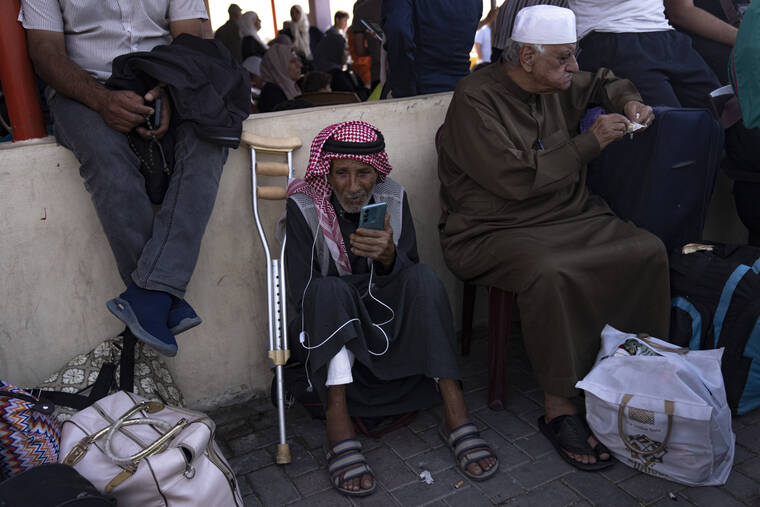
Palestinians wait to cross into Egypt at the Rafah border crossing in the Gaza Strip, on Monday, Oct.16, 2023. (AP Photo/Fatima Shbair)
RAFAH, Gaza Strip — Truckloads of aid idled at Egypt’s border with Gaza as residents and humanitarian groups pleaded Monday for water, food and fuel for dying generators, saying the tiny Palestinian territory sealed off by Israel after last week’s rampage by Hamas was near total collapse.
U.S. President Joe Biden planned to travel to Israel on Wednesday to signal White House support for the country and to Jordan to meet with Arab leaders. U.S. Secretary of State Antony Blinken announced the trip early Tuesday in Tel Aviv during his second visit to Israel in less than a week amid fears that the fighting could expand into a broader regional conflict.
In Gaza, hospitals were on the verge of losing electricity, threatening the lives of thousands of patients, and hundreds of thousands of Palestinians displaced from their homes searched for bread. Israel maintained punishing airstrikes across Gaza as a ground invasion loomed, while Hamas militants kept up a barrage of rocket attacks, and tensions mounted near the Israel-Lebanon border.
More than a week after Israel cut off entry of any supplies, all eyes were on the Rafah crossing, Gaza’s only connection to Egypt. Mediators were trying to reach a cease-fire that would let in aid and let out trapped foreigners. Israeli airstrikes forced the crossing to shut down last week, but it remained unclear Monday which of the regional actors was keeping the crossing closed.
Blinken, who returned to Israel after a six-country tour through Arab nations, said the U.S. and Israel had agreed to develop a plan to enable humanitarian aid to reach civilians in Gaza. There were few details, but the plan would include “the possibility of creating areas to help keep civilians out of harm’s way.”
“We share Israel’s concern that Hamas may seize or destroy aid entering Gaza or otherwise prevent it from reaching the people who need it,” Blinken said.
Israel evacuated towns near its northern border with Lebanon, where the military has exchanged fire repeatedly with the Iranian-backed Hezbollah group.
Speaking to the Israeli Knesset, Prime Minister Benjamin Netanyahu warned Iran and Hezbollah, “Don’t test us in the north. Don’t make the mistake of the past. Today, the price you will pay will be far heavier,” referring to Israel’s 2006 war with Hezbollah, which operates out of Lebanon.
Soon after he spoke, the Knesset floor was evacuated as rockets headed toward Jerusalem. Sirens in Tel Aviv prompted U.S. and Israeli officials to take shelter in a bunker, officials said.
Iran’s foreign minister, meanwhile, warned that “preemptive action is possible” if Israel moves closer to a ground offensive. Hossein Amirabdollahian’s threat followed a pattern of escalating rhetoric from Iran, which supports Hamas and Hezbollah.
This has become the deadliest of the five Gaza wars for both sides. At least 2,778 people have been killed and 9,700 wounded in Gaza, according to the Health Ministry there. More than 1,400 Israelis have been killed, the vast majority civilians massacred in Hamas’ Oct. 7 assault.
The Israeli military said Monday that at least 199 hostages were taken into Gaza, more than previously estimated. Hamas said it was holding 200 to 250 hostages, including foreigners whom it said it would free when it was feasible.
Also Monday, Hamas’ military wing released a hostage video showing a dazed woman having her arm wrapped with bandages. The woman, who identified herself in the video as Mia Schem, 21, rocked slightly as she spoke, the sound of explosions reverberating in the background. In her statement, Schem was taken from Kibbutz Reim, where she was attending a rave near the Israel-Gaza border. Hamas said she had undergone a three-hour operation.
The Israeli military said Schem’s family was told of her abduction last week, and officials dismissed the video as propaganda.
The plight of the hostage s has dominated the Israeli media since the attack, with interviews of their relatives playing almost constantly. Israeli officials have vowed to maintain the siege of Gaza until the hostages are released.
The head of Israel’s Shin Bet security service, in charge of monitoring militant groups, took responsibility for failing to avert Hamas’ surprise attack. As agency head, “the responsibility for that is on me,” Ronen Bar said.
“There will be time for investigation — now is a time for war,” he wrote in a letter to Shin Bet workers and their families.
The combination of airstrikes, dwindling supplies and Israel’s mass evacuation order for the north of the Gaza Strip has thrown the tiny territory’s 2.3 million people into upheaval and increasing desperation. More than 1 million have fled their homes, and 60% are now in the approximately 14-kilometer-long (8 mile) area south of the evacuation zone, according to the U.N.
The Israeli military says it is trying to clear civilians for their safety ahead of a major campaign against Hamas in Gaza’s north, where it says the militants have extensive networks of tunnels and rocket launchers. Much of Hamas’ military infrastructure is in residential areas.
Those fleeing northern Gaza still faced airstrikes in the south. Before dawn Monday, a strike in the town of Rafah collapsed a building sheltering three families who had evacuated from Gaza City. At least 12 people were killed and nine others remained buried under rubble, survivors said. The strike reduced the house to a vast crater blanketed with wreckage.
Hospitals are expected to run out of generator fuel in the next 24 hours, meaning life-saving equipment like incubators and ventilators will stop functioning and putting thousands of lives at risk, the U.N. said.
People grew increasingly desperate in their search for food and water. With taps dry, many have resorted to drinking dirty or sewage-filled water, risking the spread of disease.
More than 400,000 displaced people in the south crowded into schools and other facilities of the U.N. agency for Palestinians, UNRWA. But the agency can’t provide them supplies. UNRWA said it has only 1 liter of water a day for each of its staff members trapped in the territory.
“Gaza is running out of water, and Gaza is running out of life,” said UNRWA chief Philippe Lazzarini, calling for a lifting of the siege. “We need this now.”
The few operating bakeries had long snaking lines of people. Ahmad Salah in the city of Deir al-Balah said he waited 10 hours to get a kilo (2 pounds) of bread to feed 20-30 family members.
In northern Gaza, unknown numbers remained, either unwilling or unable to leave.
UNRWA said 170,000 people were sheltering at its schools in the north when the order to leave came. But it couldn’t evacuate them and doesn’t know if they remained. More than 40,000 have crowded in and around Gaza City’s al-Shifa Hospital, hoping it will be safe from bombardment.
Hamas urged people to ignore the evacuation order. The Israeli military on Sunday released photos it said showed a Hamas roadblock preventing traffic from moving south.
Doctors and many hospital staff have refused to evacuate, saying it would mean death for critically ill patients and newborns on ventilators. The aid group Doctors Without Borders said many of its personnel decided to stay to treat wounded. They ran out of painkillers, and staff reported “wounded screaming in pain,” it said.
On the Gaza side of the Rafah crossing, crowds of Palestinians with dual citizenship waited anxiously, sitting on suitcases or crouched on the floor, some comforting crying infants.
“They are supposed to be a developed country, talking about human rights all the time,” Shurouq Alkhazendar, whose two children are American citizens, said of the United States. “You should protect your citizens first, not leave them all alone suffering.”
After increasing cross-border exchanges with Hezbollah in the north, the Israeli military ordered residents to evacuate 28 communities within 2 kilometers (1.2 miles) of the Lebanese border.
“Israel is ready to operate on two fronts, and even more,” said Rear Adm. Daniel Hagari, a military spokesman.
Hezbollah released video showing snipers shooting out cameras on several Israeli army posts along the border, apparently to prevent Israel from monitoring movements on the Lebanese side.
The U.S. government began evacuating some 2,500 American citizens by ship from the Israeli port city of Haifa to Cyprus. Commercial airlines have largely stopped flying into Israel’s Ben-Gurion International Airport.
———
This version of the story corrects that Schem was taken from a rave at Kibbutz Reim, not from a party at Sderot.
Kullab reported from Baghdad. Krauss reported from Jerusalem. Associated Press writers Julia Frankel and Amy Teibel in Jerusalem, Abby Sewell in Beirut and Samy Magdy in Cairo contributed to this report.
Your email address will not be published. Required fields are marked *
By participating in online discussions you acknowledge that you have agreed to the TERMS OF SERVICE . An insightful discussion of ideas and viewpoints is encouraged, but comments must be civil and in good taste, with no personal attacks. If your comments are inappropriate, you may be banned from posting. To report comments that you believe do not follow our guidelines, send us an email .
- 1 New leadership for Haiti, gangs want a seat at the table
- 2 North Korea fires several cruise missiles
- 3 2 detectives looking for students disappear in Mexico
- 4 Long after pope’s abuse summit, victims still traumatized
- 5 Biden, Harris blame Trump at Virginia abortion rally
Advertisement
Supported by
Israel’s Military Campaign Has Left Gaza’s Medical System Near Collapse
The Israeli military’s bombardment and invasion of Gaza have decimated its health care system in a way that aid groups and international bodies are increasingly calling “systematic.”
- Share full article

By Vivian Nereim and Abu Bakr Bashir
Vivian Nereim reported from Riyadh, Saudi Arabia, and Abu Bakr Bashir reported from London.
Before Israel’s invasion of Gaza last year, Dr. Mahmoud Al-Reqeb worked in one of the Palestinian territory’s largest hospitals and had a private clinic, caring for women throughout their pregnancies.
Now, he lives in a plastic tent in Rafah, a Palestinian border town where roughly half of Gaza’s population has sought refuge , and treats patients for no charge in another tent. Living under Israeli bombardment, with shortages of food and clean water, the pregnant women he serves struggle to find basic safety and nourishment , let alone prenatal care.
Since the Israeli military began bombarding Gaza six months ago following the Hamas-led Oct. 7 attack, its forces have wrecked entire hospitals , struck ambulances and killed or detained hundreds of health care workers. Israeli restrictions on goods entering Gaza have prevented lifesaving medical supplies from reaching patients, according to aid groups . And shortages of fuel, water and food have made it difficult for medical workers to provide basic services.
The result has been the near collapse of a health care system that once served Gaza’s population of more than two million. By late March, of the 36 large-scale hospitals across Gaza, only 10 were “minimally functional,” according to the World Health Organization.
Israeli officials say that medical centers have been targets because Hamas fighters embed themselves within and under the facilities, and that it is the only way to root out the armed group. Hamas and medical workers have denied this accusation. Aid groups , researchers and international bodies have increasingly been calling Israel’s dismantling of Gaza’s medical capacity “systematic.”
“If you engineered the destruction of a health care system, you would end up exactly where we are today,” said Ciarán Donnelly, a senior vice president at the International Rescue Committee, an aid group that has been operating in Gaza.
Mr. Donnelly said he had worked in the humanitarian aid sector for two decades and could not think of any other war in which a medical system had been so thoroughly crushed so quickly.
Asked for comment, the Israeli military referred to previous statements it has made about Hamas fighters’ embedding themselves in facilities. Evidence examined by The New York Times suggests Hamas has used Al Shifa Hospital — which the Israeli military has raided — for cover, stored weapons inside it and maintained a lengthy tunnel. The Israeli military has not presented similarly expansive evidence about most of the other health care centers it has attacked.
Dr. Al-Reqeb’s old facility, Nasser Hospital, was raided by Israeli troops in February. When he goes to his new job, at an Emirati-funded hospital — one of the few facilities in Gaza providing specialized gynecological and obstetric services — he is one of fewer than 10 doctors treating 500 patients a day with a “severe lack of supplies, staff, medicine and equipment,” he said.
“I was very shocked when I realized the level of damage the medical system is suffering,” Dr. Al-Reqeb, 33, said in a telephone interview. “It is completely destroyed.”
In November , Human Rights Watch called for Israeli attacks on medical facilities and personnel to be investigated as war crimes. Doctors interviewed by The Times said at the time that they were performing surgeries without anesthesia and confronting filthy wounds infested with maggots because of a lack of fresh water and iodine. A W.H.O. database has recorded more than 800 “attacks on health care” in Gaza and the West Bank.
The devastation of the medical system has rippled throughout Gaza. Cancer patients have had to halt chemotherapy. People with kidney failure have lost access to lifesaving dialysis. Pregnant women have gone without the monitoring that could help identify life-threatening conditions like pre-eclampsia.
“Sometimes I cry,” said Dr. Zaki Zakzook, an oncologist who was once one of Gaza’s pre-eminent cancer doctors and now lives in a tent with his family in Khan Younis. “I’m watching my patients being executed, slowly and gradually.”
Dr. Zakzook has been able to do little for his patients since the war forced the closing of the cancer hospital where he worked, he said. He now sees patients at a hospital in the south but no longer gives them chemotherapy, fearing that doing so would weaken their immune systems at a time when the medical system is unable to cope with infection, he said. Instead, he offers palliative care, like painkillers.
“I’m trying to do my best, others are trying the same, but what can we do?” he said.
In February, Israeli forces stormed Nasser Hospital , a large facility in Khan Younis. They shelled the hospital’s orthopedic department and detained dozens of health care workers, according to Doctors Without Borders, an aid group whose staff members witnessed the attack .
“The evidence at our disposal points to deliberate and repeated attacks by Israeli forces against Nasser Hospital, its patients and its medical staff,” the organization wrote. The Israeli military said it had been searching for Hamas fighters and the bodies of Israelis taken captive during the Oct. 7 attack.
In March, the Israeli military raided Al Shifa Hospital for a second time , killing nearly 200 people it called terrorists. Israeli troops left widespread devastation in their wake after extended gun battles with Palestinian militants in and around the complex. It said its troops had come under fire from gunmen inside and around one of the hospital’s buildings. The Gazan authorities said that 200 civilians had died in the raid. Neither statement could be independently verified.
After the raid, the hospital premises were littered with bodies and shallow graves, according to the World Health Organization, which led a team this month to evaluate the hospital’s condition.
In a statement after its visit, the W.H.O. said the hospital was “an empty shell,” with no patients and most of its equipment “unusable or reduced to ashes.”
“There’s increasing evidence that a red cross or red crescent actually puts a target on you, rather than the other way around, and it is just an appalling degradation of human values,” said Dr. Tim Goodacre, a surgeon who has been traveling to Gaza for years to help train Palestinian doctors and volunteered at a hospital there in January.
Before the war, Abdulaziz Saeed’s 63-year-old father was expecting to receive a kidney transplant in March. Mr. Saeed and his mother had both been approved as potential donors. Then the war began. The doctor who was to perform the operation was killed, Mr. Saeed said, and “all our plans have been canceled.”
His family now shares its home with dozens of displaced people in the city of Deir al Balah, and his father, who previously needed three dialysis sessions a week for renal failure, is able to receive only one a week at Al-Aqsa Martyrs Hospital.
“The biggest issue is the lack of medical staff,” Mr. Saeed said. “There used to be three specialized doctors in the kidney department. Two of them were killed, and the third is unreachable.”
Anas Saad, a 24-year-old nurse at the hospital, said many of his colleagues had quit after the repeated attacks on medical facilities.
“This is no longer a safe place,” Mr. Saad said. “I am doing my best to help people survive. However, it is becoming extremely risky, as hospitals can be stormed or bombed anytime.”
Dr. Tanya Haj Hassan, an American pediatric intensive-care doctor, recently entered Gaza as part of a team of foreign doctors to volunteer at the hospital. She described “apocalyptic” scenes, including a girl who, she said, died after an Israeli bulldozer ran over a tent, crushing her, and a boy in a wheelchair whose entire family had been killed but who believed that his parents were coming to get him because “nobody has the heart to tell him.” Her account could not be independently verified.
The entirety of Gaza “just feels like it was hit by a nuclear bomb,” she said. “The reality is, they’ve taken out hospital at a time. ‘Hospital at a time’ — I can’t believe I’m even saying those words.”
Hwaida Saad contributed reporting from Beirut, Lebanon, and Johnatan Reiss from Tel Aviv.
Vivian Nereim is the lead reporter for The Times covering the countries of the Arabian Peninsula. She is based in Riyadh, Saudi Arabia. More about Vivian Nereim
Our Coverage of the Israel-Hamas War
News and Analysis
Israeli negotiators, offering a hint of hope for negotiations over a cease-fire in Gaza, have reduced the number of hostages they want Hamas to release during the first phase of a truce.
Secretary of State Antony Blinken arrived in Jordan for his second stop on a Middle East tour to meet with top officials to discuss the war between Israel and Hamas.
President Biden and his national security team see a narrow window to finally seal an agreement that would at least temporarily halt the war in Gaza and possibly even end it for good, but their optimism has been dashed before.
Campus Protests in the U.S.: On quads and lawns from coast to coast, U.S. colleges are grappling with a groundswell of student activism over Israel’s military campaign in Gaza. Administrators are having to make controversial decisions .
Cracking Down on Protests: Grief and rage over the Gaza war and Israel have led to demonstrations across the Arab world. Arrests suggest governments fear the outrage could boomerang .
Imagining Gaza’s Reconstruction: International development agencies have been meeting with Middle East business interests and urban planners to map out an economic future for the territory .
Showing Liberal Dismay: Representative Mark Pocan, the progressive Democrat from a rural, mostly white Wisconsin district, is determined to let President Biden know that it is not just young people of color who are concerned about the war .

IMAGES
COMMENTS
Explore the ancient water system of Jerusalem with a tour of the City of David, where you can walk through Hezekiah's Tunnel or the dry Canaanite Tunnel. Learn about the history and engineering of the Gihon Spring, the Pool of Siloam, and the Herodian Street.
Come and discover the secrets of Jerusalem! In this guided tour, you will walk in the footsteps of the kings and prophets, through underground passageways and in the waters of the Siloam tunnel (Hezekiah's tunnel) by flashlight. Join a magical and mysterious journey among ancient shafts, walls and fortifications of the City of David - the ...
Top ways to experience Hezekiah's Tunnel - Siloam Tunnel and nearby attractions. Discover the Secrets of the Underground Jerusalem with a private tour. from. $949.00. per group (up to 4) GoKedem 5-Day Private All-Inclusive Cross-Israel Adventure. from. $1,699.00. per adult (price varies by group size)
Explore the ancient underground tunnels and springs of the City of David, where King David founded Jerusalem 3,000 years ago. Learn about the history, archaeology and biblical stories of this site with guided tours, virtual experiences and nighttime shows.
Experiences and special content in your email. Here in the City of David, new things happen almost every day - discoveries are made, tours, special activities for the holidays, conferences, lectures and more. The City of David invites you to an experience that will connect you to the roots of the glorious past of the biblical city of Jerusalem.
Fee: 5-7 people: $59 p/p + entrance fee. 8 people and up: $59 p/p including entrance fee. Requirements: Bring hat and plenty of water. Online booking is available below for selected dates, or you can call the office in Israel on 718-701-3690 or 02-587-1718 to book all dates (within 15 hours of tour: 0522-40-90-30). Book This.
Bar Kochva Underground. A fascinating underground secret tunnel hideout used by Jews during the Bar Kochva revolt against Rome…. Explore the original ancient city of Jerusalem including King David's palace and King Hizkiyahu's water tunnel…. Jewish Tours in Israel. Book Today!
Jerusalem Location: Tour begins near by and concludes at the Dung Gate, Jerusalem. Description: Descend the Kidron Valley slope to Ir Dovid and visit the excavations of Jerusalem from the 1st Temple period. Tread through Warren's Shaft and enter underground passageways to witness the fascinating remains of King David's Jerusalem. Wade through the spectacular Water Tunnel hewn by King ...
One of the highlights of any visit to Jerusalem has to be Siloam Tunnel. This amazing feat of engineering features a 1,500 foot tunnel built in 701 BCE by King Hezekiah in an effort to protect Jerusalem's main water source, the Gihon Spring, from the Assyrians. When you go, you should expect to get a little wet as you walk through the tunnel ...
Explore the City of David's underground water tunnels and unearth secrets of the past Walk the ancestral path into Jerusalem's Old City and tour sites from the Second Temple period Descend beneath the ancient stones of the Western Wall to discover its underground tunnel network
1-844-659-5263. Recommendation from Patriarchate of Jerusalem. Tourism Website Designby One Wheel Marketing. Hezekiah's Tunnel "When Hezekiah saw that Sennacherib had come and that he intended to wage war against Jerusalem, he consulted with his officials and military staff about blocking off the water from the springs outside the city, and ...
Discover Siloam Tunnel in East Jerusalem, Israel: An ancient tunnel in Jerusalem built to redirect water in the event of a siege is one of history's great architectural innovations.
The Kotel tunnels in the western wall is the the number one tour in Israel. Being described as a "life changing experience" you might want to try it too. Saturday , 27 April 2024. ... Hasmonean Water Tunnel. The tunnel traverses the path of a Hasmonean period aqueduct. It supplied water from the north side of the city, filling up the cisterns ...
For most visitors, the highlight of a City of David visit is Hezekiah's Tunnel. The tunnel was ancient Jerusalem's primary source of water, according to the Bible. Today, you can traverse this ...
A Journey Through Timeto The Depths of Jerusalem's History The Great Stone Route The Original Western Wall Tunnels Tour The Western Wall of the Temple Mount (also known as the Kotel) is one of the most magnificent and significant remnants in Jerusalem from the days of the Second Temple, destroyed approximately 2,000 years ago. The […]
It takes about 20 minutes to walk through the tunnel today. If you feel led to travel with us and walk through the tunnel, contact Dr. John DeLancey through this website - www.biblicalisraeltours.com or email [email protected]. Enjoy the photo below! HEZEKIAH'S TUNNEL - Biblical Israel Ministries & Tours.
The Biblical City of David. Walk in the footsteps of the kings and prophets, through underground passageways and in the waters of the Siloam tunnel (Hezekiah's tunnel) by flashlights. Duration: 3 hours. From 45 25 NIS per ticket. (Ticket prices may vary depending on discounts and ticket selection)
The Western Wall Heritage Foundation is proud to present the "Western Wall Tunnels in AR 360°". A live AR 360° experience from the comfort of your very own home. The Tunnels were filmed using a state-of-the-art Augmentedl Reality technology that allows you to take a full tour of these famous Tunnels without getting up from your couch ...
Hezekiah's Tunnel, part of Jerusalem's water system, is located under the City of David. It connects the Gihon Spring—Jerusalem's fresh water supply—with the Siloam Pool.According to 2 Chronicles 32:2-4 and 2 Kings 20:20, this tunnel was dug during the reign of King Hezekiah of Judah to prepare Jerusalem for the imminent attack of the Assyrian king, Sennacherib.
Our tour of ancient Jerusalem began with a beautiful 360 degree view of eastern Jerusalem and the Old City and then continued to King David's palace. Read Part I here. From there we continued down, down, down… Pipes, water tunnels and an abyss. Entire kingdoms and stories are built around water sources.
Kotel Tunnel Tours run all day and into the night. Visitors must be accompanied by a certified tour guide. The tour is around 1.5 hours. It has some stairs, but is along a paved path. Book far in advance. Kotel Tunnel Tours sell out around holidays and vacation times.
The Western Wall Tunnels Video Tour. Jerusalem.com takes you to the underground tunnels to explore Jerusalem 2000 years ago in the days of the Second Temple. These mysterious tunnels revealed roman roads, shops and unique building skills which remained since the days of the bible. The Western Wall Tunnels, or Kotel Tunnels, pass underneath the ...
Besides the awesome experience of walking through an almost 3,000-year-old man-made tunnel, visitors - children especially - will enjoy the simple pleasure of wading through water that at times is waist-high. Get your tickets to the City of David where you can enjoy a short trek through Hezekiah's Tunnel in knee-high water.
Blinken, who returned to Israel after a six-country tour through Arab nations, said the U.S. and Israel had agreed to develop a plan to enable humanitarian aid to reach civilians in Gaza.
Children play in the water fountain in Teddy Park in Jerusalem, amid a heat wave, April 24, 2024. ... who has been hunkering down in tunnels for months and is Israel's number one target ...
The result has been the near collapse of a health care system that once served Gaza's population of more than two million. By late March, of the 36 large-scale hospitals across Gaza, only 10 ...